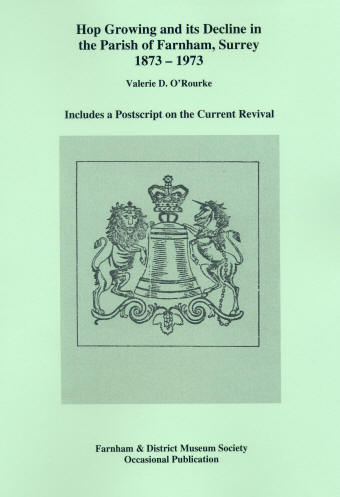 Hop Growing and
its Decline in
Hop Growing and
its Decline in
the Parish of
Farnham, Surrey
1873 – 1973
Valerie D.
O’Rourke
Includes a
Postscript on the Current Revival
.
In the town of Farnham in Surrey, for a period
from the 16th century until recently,
hops of particularly good quality were
grown.
From the 18th century
these hops were highly renowned within
the industry.
They
were of a particularly delicate flavour,
much favoured by brewers until the turn
of the century.
As a native of Farnham, the author well remembers seeing the lorries
coming round to collect the pickers each
morning during the picking season, after
the Second World War, and as each year
has passed by, she has sadly watched the
disappearance of the various hop
grounds, seeing their places being taken
by houses and schools.
This process had, however, been
going on for some 50 years before the
Second World War.
Little has so far been written in detail about
Farnham hops, and she felt that this
would be not only an interesting subject
upon which to research, but that in
recording her research, she might
contribute a little to the documentation
of Farnham’s history.
The society were therefore delighted when Mrs Valerie O’Rourke of Fleet gave this
thesis, written in 1986, to the Museum
Society, with permission to use it in
whatever way we thought best.
Mrs O’Rourke was a mature student at the Sydney
Webb College of Education in London, and
prepared the work towards her Teacher’s
Certificate in 1976.
As you will see it represents
many hours of painstaking study, and
includes some unique reminiscences by
local people whose memories went back to
the end of the Farnham hop era.
Very few copies survive of the 1986
edition of Valerie O’Rourke’s thesis,
and Maurice Hewins suggested that his
copy could be used as the basis for a
new transcription, so that it could be
circulated more widely among the many
Farnham people interested in the
subject.
The quality of the original
photocopied illustrations proved to be
too poor for reproduction, but Maurice
has kindly loaned sufficient photographs
from his collection; he credits some of
these to Jim Tice, a former hop grower.
62 pages
29 illustrations

